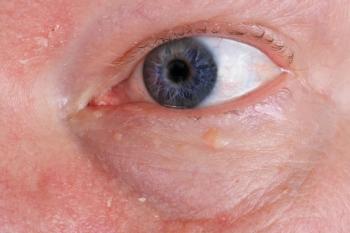
- Vol. 10 No. 07
- Volume 10
- Issue 7
Resveratrol may be key in AMD stroke patient treatments
Anti-VEGF treatments are used in many aspects of retinal eyecare, but when applied to patients who just suffered a stroke, mortality rates appear to rise. We explore the nutrient molecule resveratrol and how it may be the key in treating these patients.
A choice was presented to the eyecare community with the publication of mortality data concerning combined stroke/age-related macular degeneration (AMD) patients.1 Eyecare practitioners now know that intravitreal anti–vascular endothelial growth factor injections (anti-VEGF) used in stroke victims, must be used with extreme care- especially in the immediate stroke aftermath.
The adjusted mortality in patients who received bevacizumab (Avastin, Genentech) within three months after stroke/transient ischemic attack (TIA) is significantly different than in patients not exposed to bevacizumab (OR = 6.92, 95 percent, CI 1.88-25.43, p < 0.01). That is nearly a seven times higher risk of death.1
Dangers of overuse
The Comparison of AMD Treatments Trials (CATT) follow-up study provides the most complete up-to-date review of the long-term outcomes of treatment of neovascular AMD with anti-VEGF drugs.2
Approximately 40 percent of eyes receiving anti-VEGF therapy deteriorated into geographic atrophy in years two through five, with a higher percentage of enrolled eyes in regimented monthly treatments.2
When and if a blockage of a cerebral (or coronary) artery occurs, the cerebral (or cardiac) tissue is protected by prior resveratrol-activated preconditioning. This biological phenomenon called “hormesis” was discovered by Russian physician Felix Meerson, MD.
Previously from Dr. Richer:
By inducing hormesis, protective cellular internal antioxidant enzymes (glutathione, catalase, superoxide dismutase) are activated prior to a stroke (or heart attack), so when blood circulation is restored there will not be any resultant cardiac or heart muscle damage (called reperfusion injury).3 Resveratrol and other “red wine” molecules induce hormesis.4
Resveratrol shows promise
Resveratrol metabolites have recently been detected in the eye after oral administration, signifying its ability to cross protective barriers and reinforce its potential benefit to vision conditions beyond its well-known protective role against heart disease and cancer.5
Evidence is mounting on resveratrol’s side as its anti-inflammatory, antioxidant, and anti-aging activity via different molecular mechanisms that have been highlighted in animal models and in vitro retinal cells.6 Resveratrol is the ideal candidate nutrient for an AREDS 3 clinical trial.7
Longevinex is the only resveratrol product to have undergone toxicity testing. The manufacturer has spent 15 years publishing science and petitioning the FDA to fast-track its use in AMD.8,9
Post-AREDS II science also suggests a vulnerable fovea is protected by foveal targeting zeaxanthin isomers in higher doses than used in the AREDS II study. I have written about this other red nutrient derived from paprika, that reduces both the personal and economic anti-VEGF injection burden.7,10
The choice is yours
As multispectral retinal imaging, spectral domain optical coherence tomography (SD-OCT), and other sophisticated imaging modalities become more welcomed by insurance companies looking to prevent bilateral disease and save money, the OD becomes the first-in-line eyecare provider in identifying retinal disease.
Some ODs now offer adjunctive therapy beyond anti-VEGF injections. Imaging quiescent pre-diabetic foveal micro-aneurysms and subclinical AMD quiescent sub-retinal neovascularization, combined with preventative molecular nutritional medicine, is here.11
References:
1. Hanhart J, Comaneshter DS, Vinker S. Mortality after a cerebrovascular event in age-related macular degeneration patients treated with bevacizumab ocular injections. Acta Ophthalmol. 2018 Apr 16. doi: 10.1111/aos.13731. [Epub ahead of print]
2. Comparison of Age-related Macular Degeneration Treatments Trials (CATT) Research Group. 5-Year Outcomes with Anti-VEGF Treatment of Neovascular Age-related Macular Degeneration (AMD): The Comparison of AMD Treatments Trials. Ophthalmology. 2016 Aug; 123(8):1751–1761.
3. Mukherjee S, Ray D, Lekli I, Bak I, Tosaki A, Das DK. Effects of Longevinex (modified resveratrol) on cardioprotection and its mechanisms of action. Can J Physiol Pharmacol. 2010 Nov;88(11):1017-25.
4. Calabrese EJ, Mattson MP, Calabrese V, Resveratrol commonly displays hormesis: occurrence and biomedical significance, Hum Exp Toxicol. 2010 Dec;29(12):980-1015.
5. Wang S, Wang Z, Yang S, Yin T, Zhang Y, Qin Y, Weinreb RN, Sun X. Tissue Distribution of trans-Resveratrol and Its Metabolites after Oral Administration in Human Eyes. J Ophthalmol. 2017; 2017: 4052094. doi: 10.1155/2017/4052094. [Epub ahead of print]
6. Kalea AZ, Drosatos K, Buxton JL, Nutriepigenetics and cardiovascular disease, Curr Opin Clin Nutr Metab Care. 2018 Jul;21(4):252-259.
7. Richer S, Ulanski L, Popenko NA, Pratt SG, Hitchmoth D, Chous P, Patel S, Sockanathan S, Sardi B. Age-related Macular Degeneration Beyond the Age-related Eye Disease Study II. Advances in Ophthalmology and Optometry. Elsevier Press: Philadelphia, 2016 Aug;(1) pp. 335-369. ISBN: 13: 978-0-323-50919-0.
8. Resveratrol Partners LLC. Petition To The U.S. Food & Drug Administration. Available at: http://www.longevinex.com/pdf/LongevinexAMDFDAPetition.pdf. Accessed 6/14/18.
9. Sangeetha MK, Vallabi DE, Sali VK, Thanka J, Vasanthi HR. Sub-acute toxicity profile of a modified resveratrol supplement. Food Chem Toxicol. 2013 Sep;59:492-500.
10. Richer SP, Cebold B, Katkar M, Huntjens B, Pratt SG, Stiles W, Ulanski L, Gierhart D. Restoration of Central Macular Pigment Dip with Dietary RR Zeaxanthin Supplementation in Patients with AMD. Adv Ophthalmol Vis Syst. 2017. 7(3):00219.
11. Gelb KM, Richer SP, Zimmer CN, Sherman J, Gold JM. Retinal multispectral imaging of ‘subclinical’ capillary micro-aneurysms in non-diabetics correlates with insulin resistance, Diabesity. 2016, 2(3):19-25.
Articles in this issue
over 7 years ago
GPC leads to contact lens instabilityover 7 years ago
Eyelid taping may offer temporary alternative to blepharoplastyover 7 years ago
Peroxide lens care effective for GP lens wearersover 7 years ago
Use MIGS prior to late-stage glaucomaover 7 years ago
Why documenting target IOP helps ODsover 7 years ago
Demand for optometry projected to growover 7 years ago
4 tips to help staff identify contact lens candidatesabout 8 years ago
3 tips to upgrading astigmatic contact lens patientsNewsletter
Want more insights like this? Subscribe to Optometry Times and get clinical pearls and practice tips delivered straight to your inbox.













































